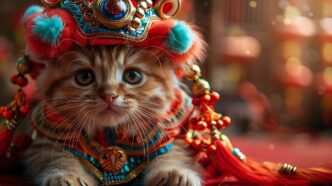The single most common mistake people make when determining their Chinese Zodiac animal is using the wrong calendar. For anyone born in January or February, a quick check of their birth year against the Gregorian calendar—the standard solar-based system used worldwide—can lead to an incorrect zodiac assignment. The authentic animal sign is determined by the Chinese lunisolar calendar, where the New Year, known as the Spring Festival or Lunar New Year, begins on a different date each year, typically falling between January 21st and February 20th. Understanding this critical distinction is the essential first step to accurately identifying your zodiac animal and unlocking the personal insights and annual guidance this ancient system provides.
The Global Standard: The Gregorian Calendar
The Gregorian calendar is the internationally accepted civil calendar and the one most of us use to mark birthdays, anniversaries, and holidays. Introduced by Pope Gregory XIII in 1582, it is a purely solar calendar, designed to keep the seasons aligned with the months over long periods.
Its structure is based on the time it takes for the Earth to complete one full orbit around the sun, which is approximately 365.2425 days. The calendar accommodates this fraction by adding a “leap day” on February 29th nearly every four years.
This system provides a fixed and predictable framework for global commerce, travel, and communication. However, its New Year’s Day is always on January 1st, a date that has no connection to the lunar cycles or the traditional agricultural markers that form the foundation of Chinese astrology.
The Rhythm of Nature: The Chinese Lunisolar Calendar
The Chinese calendar, in contrast, is a complex and sophisticated timekeeping system known as a lunisolar calendar. It masterfully blends the cycles of both the moon and the sun, reflecting a cultural philosophy deeply rooted in observing the rhythms of the natural world.
Tracking the Moon’s Phases
At its core, the calendar is lunar. Each month begins on the day of the new moon, when the moon is not visible in the sky. Because a lunar cycle is about 29.5 days long, a lunar year of 12 months adds up to approximately 354 days.
This creates an 11-day shortfall compared to the 365-day solar year. If left uncorrected, the Lunar New Year would drift backward through the seasons, eventually occurring in the summer or autumn, which would contradict its name as the “Spring Festival.”
Aligning with the Seasons
To solve this, the Chinese calendar incorporates the sun’s cycle by adding an extra month, called an intercalary month (闰月, rùnyuè), every two to three years. This 13th month ensures that the calendar remains synchronized with the solar year and, by extension, the agricultural seasons.
This elegant solution allows the calendar to honor the moon’s phases while ensuring that significant events like the Spring Festival always occur at the appropriate time of year. It is this lunisolar nature that makes the start of the year a moving target from a Gregorian perspective.
Why Your Birth Date is More Complicated Than You Think
The shifting date of the Lunar New Year is the primary source of confusion for determining one’s zodiac sign. The annual changeover from one zodiac animal to the next does not happen on January 1st; it happens on the Lunar New Year’s Day.
The January/February Dilemma
Consider someone born on January 30, 1982. A quick glance at a standard zodiac chart might suggest they were born in the Year of the Dog, which began in 1982. However, the Lunar New Year in 1982 fell on January 25th. Since their birthday is after this date, they are indeed a Dog.
Now, let’s look at their friend, born just a week earlier on January 23, 1982. Although they were also born in the Gregorian year of 1982, their birth date falls before the Lunar New Year. Therefore, they were born at the very end of the previous lunar year, making their zodiac sign the Rooster of 1981.
To illustrate, here are the Lunar New Year dates for several recent years:
- 2024 (Year of the Dragon): February 10
- 2023 (Year of the Rabbit): January 22
- 2022 (Year of the Tiger): February 1
- 2021 (Year of the Ox): February 12
- 2020 (Year of the Rat): January 25
Anyone with a birthday before these dates in their respective years belongs to the previous year’s zodiac animal. This is not a matter of interpretation but a fundamental rule of the system.
An Even Deeper Layer: The Start of Spring (Lichun)
For those seeking a more profound understanding, there is another layer to this calendrical distinction. While the Lunar New Year (春节, Chūnjié) marks the cultural and popular start of the zodiac year, many professional astrologers and Feng Shui masters use a different date: Lichun (立春), or the “Start of Spring.”
Lichun is the first of the 24 Solar Terms (二十四节气, èrshísì jiéqì) of the traditional East Asian lunisolar calendars. These terms are based entirely on the sun’s position on the ecliptic and mark key agricultural and seasonal shifts. Lichun typically falls on February 4th or 5th of the Gregorian calendar.
The Farmer’s Calendar vs. The People’s Calendar
This creates two “New Years.” The Lunar New Year is the celebratory, public festival. Lichun, however, is considered the true energetic start of the year in systems like Bazi (八字), or the Four Pillars of Destiny, which is a highly detailed form of Chinese astrological forecasting.
The Bazi system relies on the Hsia Calendar (夏历), or “Farmer’s Calendar,” which is solar-based. For a Bazi practitioner, the energetic shift from one ruling animal to the next occurs precisely at Lichun, not on the day of the new moon.
Which One Should You Use?
For the vast majority of people, using the Lunar New Year date is perfectly correct. It is the universally recognized start of the zodiac year for cultural identity, general horoscopes, and compatibility checks. This is the date that defines whether you celebrate as, for example, a Tiger or a Rabbit.
The Lichun date is primarily relevant for those engaging in a professional Bazi reading or a serious Feng Shui analysis of their home or business. If you were born between the Lunar New Year and Lichun, a Bazi master might consider you to belong to the new year’s animal, even if popular tradition places you in the previous year. This nuance highlights the rich complexity within Chinese metaphysics.
Why Your Correct Sign Matters
Taking the time to verify your true zodiac animal is more than just a matter of trivia. Your correct sign is the foundation upon which all other astrological insights are built, impacting everything from self-perception to life strategy.
Personal Identity and Traits
Each of the twelve animals represents a distinct archetype with a unique set of personality traits, strengths, and weaknesses. If you believe you are an assertive Dragon when you are, in fact, a more diplomatic Rabbit, you are working with a fundamentally flawed blueprint for self-understanding.
Compatibility and Relationships
One of the most popular applications of the Chinese Zodiac is relationship compatibility. The system outlines which signs are most harmonious (e.g., the Trines of Affinity) and which are prone to conflict. These predictions are rendered meaningless if one or both individuals are using the wrong sign.
Annual Fortunes and Auspiciousness
Every year, detailed forecasts are published outlining how each of the twelve zodiac animals will fare under the influence of the year’s ruling animal. These guides offer advice on career, wealth, health, and relationships. Following the advice for a Horse during the Year of the Rat when you are actually a Snake could lead to misguided decisions and missed opportunities.
Embracing Your Authentic Astrological Identity
Ultimately, the Chinese Zodiac is a tool for self-discovery, and its accuracy hinges on a correct starting point. The journey begins not with a simple lookup of your birth year, but with an appreciation for the ancient lunisolar calendar that governs the system. For those born in the transitional period of January or February, confirming your sign against the specific Lunar New Year date of your birth year is a crucial act of astrological diligence. By embracing your authentic sign, you gain a clearer lens through which to view your personality, your relationships, and the path that lies ahead.








